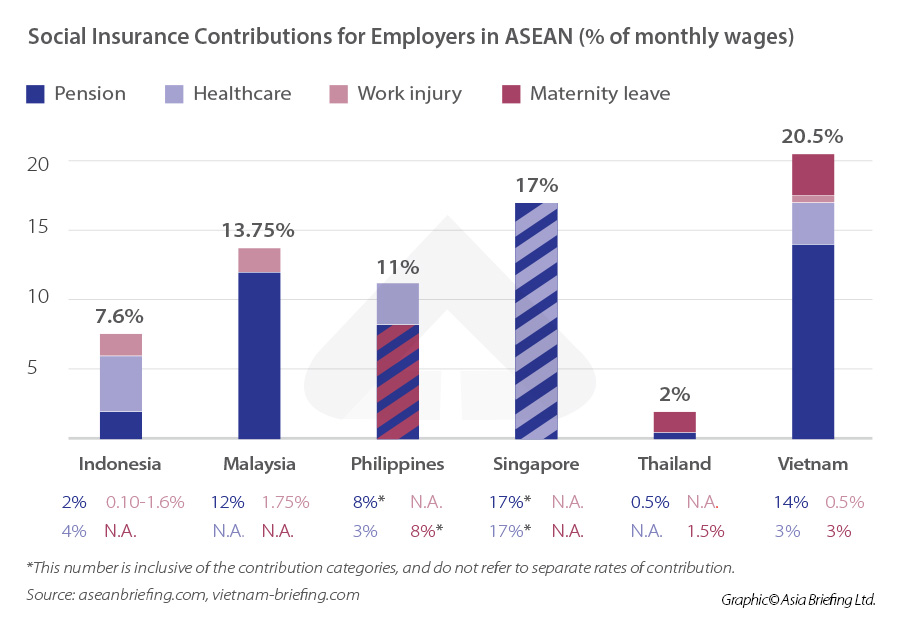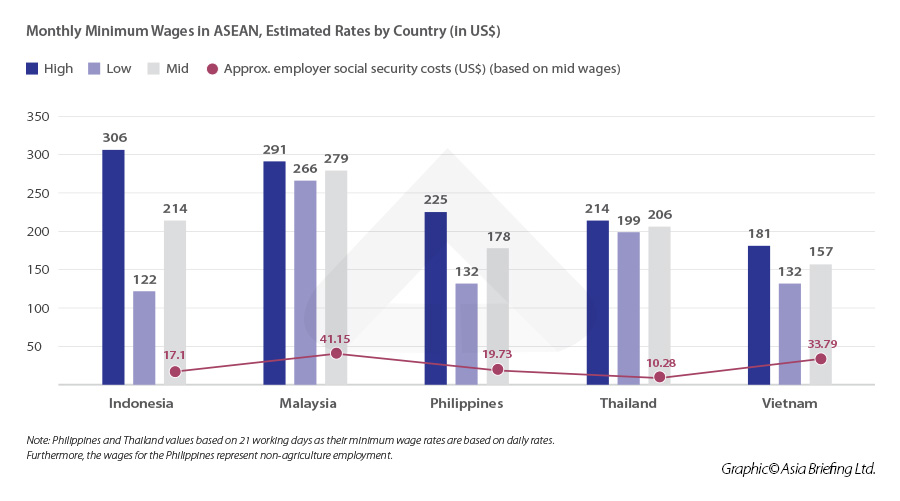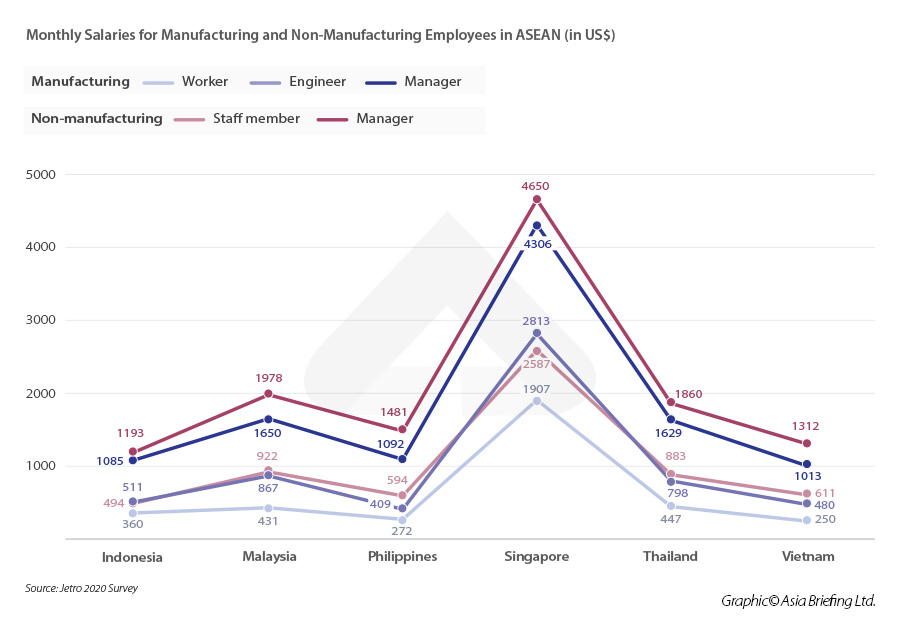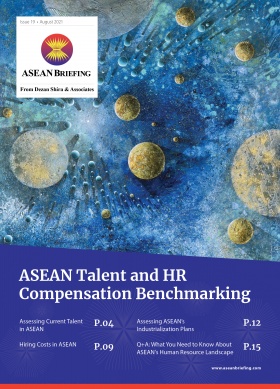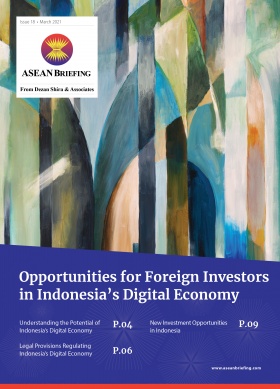Hiring Costs in ASEAN
Minimum wage rates across ASEAN countries are rising gradually to match the region’s increased cost of living and boost domestic demand. Despite rising salaries, minimum wages in most ASEAN countries remain significantly lower than those in the developed economies of the world.
Moreover, foreign investors should be aware that ASEAN governments are increasing social protection expenditure and businesses now must consider the expansion of coverage in areas such as pensions, health coverage, and welfare assistance when assessing labor costs. These costs will vary considering ASEAN members are heterogeneous in their economic structures, development, and thus prioritization of social protection goals.
Indonesia
Minimum wage
Indonesia’s Ministry of Manpower issued circular No. M/11/HK.04/X/2020 in late October 2020, which advised that due to the economic impact of the pandemic, regional governments should keep monthly minimum wage rates the same as 2020.
Of Indonesia’s 34 provinces, only five have decided to increase the minimum wage for 2021. Calculations for the monthly minimum wage are carried out by the provincial or district wage council.
The local government will determine the minimum wage based on economic and employment conditions. These comprise of the following variables: • Purchasing power parity; • Manpower absorption levels; and • Median wage variables (the margin between the 50 percent of the highest wages and 50 percent from the lowest 50 percent of the lowest wages from employees in the same position).
Social insurance
Indonesia’s social security programs are run by two organizations — the Social Security Administrator for Health (BPJS Kesehatan) and the Workers Social Security (BPJS Ketenagakerjaan) — for pensions. The government has made it mandatory for all Indonesian citizens and expatriates to participate in social security programs. Expat employees must also enroll their families in the programs.
Healthcare
Five percent of an employee’s monthly salary will go towards paying for the healthcare premium, with a salary cap of 12 million rupiah (US$821). Workers in the private sector will pay one percent, and the remaining four percent will be paid by their employer. For civil servants, the government contributes three percent, and the employee, two percent.
Further, the premium covers the employee’s spouse and three dependent children up to the age of 21.
Pension
The pension program under BPJS Ketenagakerjaan covers the following:
- Accident compensation – provides protection for accidents occurring during or as a result of work;
- Old age benefits – provides protection for participants that are in retirement, laid off;
- Pension benefits – provides guaranteed income in retirement; and Life insurance – upon the death of the participant, their heirs can claim the benefits.
Malaysia
Minimum wage
Malaysia’s 2020 monthly minimum wage rates are set to continue to 2021, although the government will launch a review later in 2021 to ensure earnings remain relevant to current economic conditions. The monthly minimum wage in 56 major cities is 1,200 ringgit (US$291), whereas the minimum wage in non-urban areas and rural towns is 1,100 ringgit (US$266).
Social insurance
Employers and employees are required to make monthly contributions to the social security fund managed by the Malaysian Social Security Organization (SOCSO). Contributions are capped at the monthly wage of 4,000 ringgit (US$963). The monthly contributions fall under two categories:
Employment injury and invalidity scheme
This scheme provides protection against accidents or occupational disease arising from one’s employment and is obligatory for employees under the age of 60. The employee contributes 0.5 percent from their monthly wage while the employer contributes the remaining 1.75 percent.
Employment injury scheme
Employees who have reached the age of 60 will have to contribute 1.25 percent of their monthly wage to this scheme, payable by the employer. The scheme provides protection against someone who has died due to their employment or suffered from invalidity due to their employment.
Philippines
Minimum wage
The Philippines has daily minimum wage rates that vary from region to region, ranging from PHP316 (US$6.57) to P537 (US$11.17) a day for 2021. The wages are set by tripartite regional wage boards located in every region.
Social insurance
In the Philippines, the employer and employee must make social security contributions to the Philippine Health Insurance Corporation (PhilHealth) and the Social Security System (SSS). This monthly amount corresponds to the salaries of the covered employees.
The Philippine Health Insurance Corporation (PhilHealth) implements the country’s universal healthcare program, providing Filipinos with access to affordable healthcare services and financial assistance. The SSS provides maternity leave, funeral, disability, retirement, death, sickness, involuntary separation, and unemployment benefits, with all private employers and employees obligated to join the program. Monthly contributions made by employers and employees in the formal sector to PhilHealth are between PHP150 (US$3.14) to PHP900 (US$18.86). For monthly SSS contributions, the employer’s contributions are between PHP160 (US$3.35) and PHP1,600 (US$33.53) whereas for employees, the contribution rates are between PHP80 (US$1.67) and PHP800 (US$16.76).
Singapore
Singapore does not have a minimum wage, but it does have a comprehensive social insurance system. The Central Provident Fund (CPF) is a social security savings scheme, in which contributions are mandatory for citizens and permanent residents only. Foreign workers are not eligible for the CPF scheme. Employers and employees contribute 17 percent and 20 percent, respectively, of ordinary monthly wages, up to an income ceiling of S$6,000 (US$4,530). The rates are applicable to employees aged 55 years and below.
Thailand
Minimum wage
The daily minimum wage in Thailand is between 313 baht (US$10.03) — 336 baht (US$10.77) for 2021.
Social insurance
The employee must pay five percent of the first 15,000 baht (US$481) earned per month towards the social security contribution. The employer also contributes five percent.
The contribution to the social security fund is divided into:
- Disability, maternity, and death benefits;
- Child and old-age benefits; and
- Unemployment benefits.
Vietnam
Minimum wage
Vietnam sets a different minimum wage level across its four regions. Region I (urban Hanoi and Ho Chi Minh City) registered the highest minimum wage of VND 4,200,000 (US$181) while Region IV registered the lowest at VND 3,070,000 (US$132). Moreover, employees that have had vocational training must be paid at least seven percent higher than the applicable minimum wage rate.
Social insurance
There are three types of mandatory social security in Vietnam that must be covered by foreign enterprises seeking to hire local staff:
- Social insurance;
- Health insurance; and
- Unemployment insurance.
Employers register and pay insurance contributions monthly on behalf of their employees at the provincial Department of Labor, Invalids, and Social Affairs (DoLISA). Contributions are determined based on employees’ monthly salaries or wages.
About Us
ASEAN Briefing is produced by Dezan Shira & Associates. The firm assists foreign investors throughout Asia and maintains offices throughout ASEAN, including in Singapore, Hanoi, Ho Chi Minh City, and Da Nang in Vietnam, Munich, and Esen in Germany, Boston, and Salt Lake City in the United States, Milan, Conegliano, and Udine in Italy, in addition to Jakarta, and Batam in Indonesia. We also have partner firms in Malaysia, Bangladesh, the Philippines, and Thailand as well as our practices in China and India. Please contact us at asia@dezshira.com or visit our website at www.dezshira.com.
- Previous Article Three Key Factors Impacting Human Resource Development in ASEAN
- Next Article The ASEAN-Russia Trade and Investment Cooperation Roadmap
